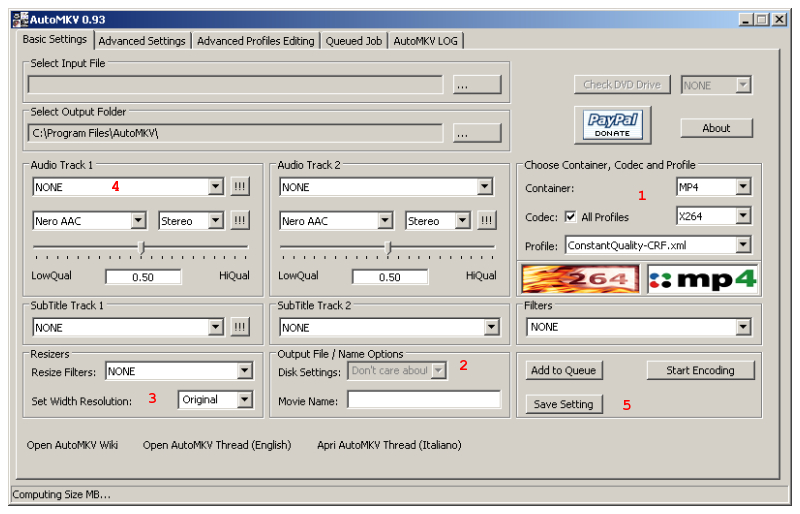| AutoMKV Installation and Configuration | You are viewing Page 3 of 5 -- Go to page 1 , 2 , 3 , 4 , 5 |
The Basic Settings Tab
As the name implies, the settings on this tab determine the basic elements of your encoded video, audio, and perhaps also subtitles. There are a number of decisions you can make here that will determine whether your output file is compatible with a particular player or application. The settings on this tab can be saved as defaults and used each time you start AutoMKV.

1. Container
The container you choose for your output affects not only which hardware can play it, but in some cases also the type of streams commonly supported. Although AVI files were once the standard for MPEG-4 video, the advantages of both the official MPEG-4 container (.MP4) and the Matroska container (.MKV), AVI's usefulness is generally limited to encoding for older standalone DVD players with MPEG-4 (DivX, XviD, etc,...) support. If your audio is going to be in any format other than AAC, MP4 is generally a poor choice as well. MKV, on the other hand, is well suited to nearly any video or audio format, and while not yet supported in hardware like DVD players and portable media players, it's well suited to computer-based playback.
For Windows Media Video encoding only the WMV container can be used. This is a limitation of the Microsoft encoder.
Encoder and Profile
Once you've selected a container you'll have a list of available codecs. Once you select the encoder you'll have either a short list of profiles available or, if you check the All Profiles checkbox, a long list. Each profile has a name describing the settings in some way, such as the number of passes, whether constant quality is being used, and what type of device can playback the video. If you need to reach a particular size you'll want to avoid the CQ (constant quality) settings and concentrate on the 2 pass profiles.x264's and Constant Quality
If you've decided you prefer to do all your encoding to a particular quality rather than a pre-determined filesize you will likely select a constat quality profile of some kind. For x264 you'll be given the choice of either QP (constant quantizer) or CRF (constant rate factor) encoding. While you may be familiar with constant quantizer encoding from other video encoders, CRF encoding will give you generally superior results. Constant quantization has a tendency to either waste bits where the extra detail is invisible, and in the process limit the bitrate available to areas that could use more bits to represent details.2. Output File Size
If you've selected a bitrate based encoding strategy (instead of CQ) AutoMKV can calculate the required video bitrate based on your selections for other (audio and subtitle streams) and an output size. If you would like all, or even the majority of your encodes to be the same size you can set it as a default here. If you want to calculate the bitrate to use instead of leaving that task up to AutoMKV you should set this option to Don't care about size. If you're encoding using a constant quality mode this setting will be unavailable.
3. Resizers
If you'd like to resize your video before encoding, AutoMKV can add the appropriate lines to the AVS file which will be used for video encoding. If you want to resize, but aren't sure which resizing method will give you the "best" results you should try them for yourself to find out first hand. If that's too much trouble for you there are descriptions along with some of the resize options which tell you if there is any smoothing (blurring) or sharpening involved. A method noted as neutral doesn't do a lot of sharpening or smoothing to the image. While sharper images generally look better to the human eye, smooth images compress better because they have less detail.
You're not required to resize just because you're re-encoding. If you prefer not to do any resizing by default you can select NONE.
4. Audio Tracks
You can select up to two audio tracks to mux with the encoded video output. The audio can either be transcoded to a format like AAC or MP3 or kept with no modification. Here is where your choice of container also becomes important. If you're creating a MP4 file you should use AAC audio. Both the Nero and Coding Tech AAC options should give you good results. If your final destination is an AVI file you'll want to stick with either MP3 or AC-3 (Dolby Digital). If you're converting to a MKV file you have the widest variety of options. Since Matroska is specifically designed to work with any codec, there should be no issue using just about any kind of audio you want in your MKV files.
5. Save Settings
After setting the general options you want to use as defaults you can save your settings. From now on these settings will already be configured when you start AutoMKV.
Continued On Page 4Next we'll take a look at some Advanced Settings. Although many of the options on the Advanced Settings tab may vary from one encoding job to the next, if you're like me you probably have some default settings you like to start with. If you're not sure yet what kind of video you'll be encoding from, or where you'll be playing it back you may not be ready to set any defaults, but should still familiarize yourself with the settings. Page 4 - Advanced Settings | |
| AutoMKV Installation and Configuration | You are viewing Page 3 of 5 -- Go to page 1 , 2 , 3 , 4 , 5 |
Written by: Rich Fiscus

